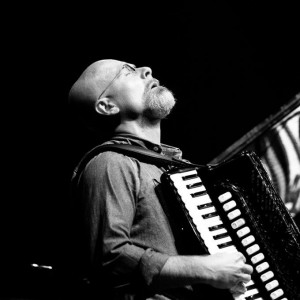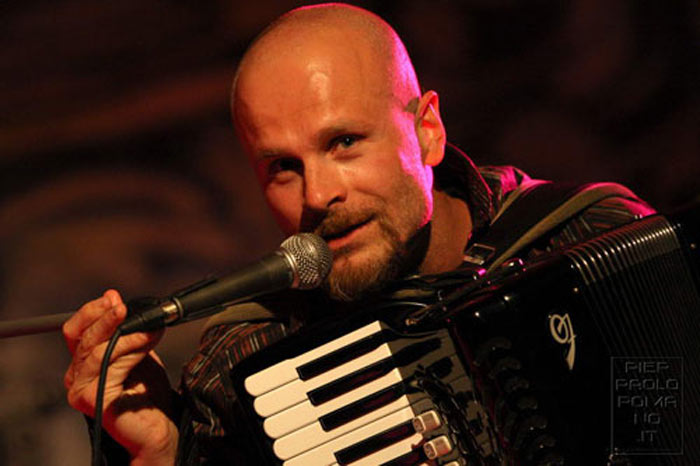Ermes Pirlo: il suono prima di tutto
 Ermes Pirlo è un fisarmonicista e compositore assai interessante. Costantemente immerso nella ricerca di un suono riconoscibile, strettamente personale, basa il suo modo di suonare sulla cantabilità e sulla vasta esplorazione timbrica, armonica, ritmica e melodica. Attraverso questa intervista racconta uno spaccato della sua vita.
Ermes Pirlo è un fisarmonicista e compositore assai interessante. Costantemente immerso nella ricerca di un suono riconoscibile, strettamente personale, basa il suo modo di suonare sulla cantabilità e sulla vasta esplorazione timbrica, armonica, ritmica e melodica. Attraverso questa intervista racconta uno spaccato della sua vita.
Da dove deriva la tua passione per la fisarmonica?
Mio padre ha sempre amato questo strumento, pur non avendo avuto tempo da dedicargli. A nove anni mi regalò la prima fisarmonica e mi fece prendere lezioni da un insegnante del paese. Sin da subito capii che il rapporto tra me e questo strumento sarebbe durato a lungo, considerato che l’approccio fu di immediata naturalezza e le piccole soddisfazioni arrivavano praticamente di giorno in giorno.
Nel 2006 hai frequentato i seminari di Siena Jazz, una tra le istituzioni più blasonate in Italia per quanto concerne questo genere musicale. Come hai vissuto questa esperienza formativa?
L’esperienza a Siena è stata molto formativa. Ho conosciuto docenti, ma anche musicisti di altissimo livello con i quali ho condiviso momenti che credo solo esperienze simili possano regalare. Ho avuto modo di conoscere il pianista/”ricercatore” Stefano Battaglia, con cui nei quattro anni successivi ho intrapreso un percorso di ricerca musicale legato all’improvvisazione libera a tabula rasa, che mi ha fatto crescere tantissimo in termini di visione analitica del materiale sonoro e di capacità performativa.
Successivamente, sempre all’insegna di un’accurata crescita artistica, hai frequentato i seminari internazionali Jazzinty in Slovenia, dove sei stato inserito nella classe di musica d’insieme diretta da uno fra i più stimati chitarristi jazz mondiali: John Abercrombie. Come è stato l’incontro con questo gigante della musica?
Sono andato in Slovenia per seguire un workshop tenuto da Simone Zanchini, uno dei fisarmonicisti che più stimo e che da sempre seguo con interesse. Abercrombie era il mentor della classe di chitarra. Oltre ad essere il musicista che tutto il mondo conosce, si rivelò una persona genuina che si sorprese per il fatto che conoscessi alcuni suoi brani (ho sempre apprezzato il suo linguaggio legato alla cantabilità della melodia) e si mostrò piacevolmente incuriosito da questa “accordion version” della sua musica.
Nel 2011 hai costituito un trio denominato Bellow’s Training con il quale hai inciso un disco di sole composizioni originali. Qual è il fil rouge che contraddistingue questo album?
Il suono. Abbiamo lavorato sul suono. Con il bassista e amico bresciano Paolo Biasi ho cominciato a scrivere per Bellow’s Training nel 2010. Ci trovavamo con decorrenza settimanale e il materiale proposto da entrambi veniva trattato senza troppe regole teoriche, bensì ci concentravamo sul suono e sull’interazione strumentale. Conoscevamo da tempo il batterista/pianista Emanuele Maniscalco, musicista di rara sensibilità e completezza (anche lui bresciano e già stretto collaboratore di Paolo) al quale abbiamo chiesto, in un secondo tempo, di far parte del nostro progetto. Il suo inserimento fu stimolante per noi, al punto di documentare il lavoro svolto sino ad allora. Registrammo nel 2012 e il disco uscì nel 2015 per l’etichetta NBN.
In che modo nascono, dal punto di vista squisitamente emozionale, i brani di tua penna?
Non c’è un’unica risposta. Alcune volte la musica esce ancora prima che me ne renda conto e si tratta solo di darle una forma compiuta. Diciamo che i brani più sinceri sono ovviamente quelli legati a momenti particolari che mi hanno ispirato.
Per quanto concerne le tue composizioni originali, prediligi concepirle seguendo un unico genere oppure ti immergi in una ricerca stilistica incardinata su svariati stilemi?
Non credo abbia senso parlare di un unico genere, soprattutto per chi suona e ascolta il jazz, il linguaggio delle molteplici contaminazioni. Non sono mai stato un purista del genere musicale, ancor meno nella scrittura. In linea di massima le cose più interessanti che concepisco partono da un soggetto strutturale al quale cerco di dar vita sonora, rimanendo lontano da cliché o stilemi abusati per linguaggio e per forma, a favore di una scrittura più semplice che mi permetta di raccontare una storia che sia la più evocativa possibile.
 Nel corso dell’ultimo decennio hai notato una presenza costante della fisarmonica nella musica contemporanea o credi che questo strumento possa essere maggiormente valorizzato e impiegato più spesso?
Nel corso dell’ultimo decennio hai notato una presenza costante della fisarmonica nella musica contemporanea o credi che questo strumento possa essere maggiormente valorizzato e impiegato più spesso?
È innegabile che negli ultimi anni la fisarmonica si stia riprendendo lo spazio che le è stato negato per molto tempo, almeno nell’ambito del jazz mainstream, grazie a fisarmonicisti che hanno interiorizzato questo linguaggio. Nella musica classica contemporanea credo che la sperimentazione possa portare nuova linfa a questo strumento. Penso che bene hanno fatto e fanno coloro (fisarmonicisti e compositori) che investono risorse in questa direzione.
Ritieni che la fisarmonica sia uno strumento necessariamente legato a un determinato genere musicale oppure, grazie al suo inesauribile potenziale timbrico ed espressivo, pensi che si possa suonare tranquillamente in qualsiasi contesto?
Non c’è dubbio che la fisarmonica sia unanimemente considerata uno strumento versatile. A fronte dei pochi limiti che comunque ha (ogni strumento ha i propri), essa offre un potenziale timbrico, armonico, ritmico e melodico grazie al quale può tranquillamente essere presente in ogni genere. Direi che l’unica accortezza stia nel dosare opportunamente tutto questo potenziale in virtù dell’organico e del contesto nel quale viene inserito.
Dal 2015 collabori proficuamente con il chitarrista Paolo Bacchetta, in un progetto improntato sul suono del duo che comprende brani originali e d’autore. Quali sono le caratteristiche predominanti delle composizioni originali e dei brani d’autore?
Paolo Bacchetta, anche egli bresciano (mi ritengo un privilegiato vivendo a Brescia, poiché sono circondato da alcuni tra i migliori improvvisatori presenti sulla scena nazionale), lo conobbi durante l’esperienza a Siena nel 2006. Ci siamo ritrovati recentemente e c’è stata quella giusta sintonia che ti spinge ad osare e, per quanto mi riguarda, a rimettere in discussione il ruolo della fisarmonica. La caratteristica predominante è ancora il suono, a prescindere dal materiale, con un occhio di riguardo all’equilibrio delle tensioni, considerata la natura iperarmonica dei due strumenti.
Sei proiettato verso nuovi progetti discografici?
L’intento è quello di continuare il percorso iniziato con Bellow’s Training con l’aggiunta di un quarto elemento. Abbiamo già del materiale registrato in studio nel 2012, che però decidemmo di non pubblicare, perché troppo distante dal colore che stava prendendo buona parte del disco. Da allora è stata scritta nuova musica, che aspetta solo tempi maturi per una nuova pubblicazione.
————————————————————————————
Ermes Pirlo: the sound first of all
 Ermes Pirlo is a very interesting accordionist and composer. Constantly immersed in the search for a strictly personal and recognisable sound, it bases its way of playing on songwriting and extensive timbre, harmonic, rhythmic and melodic exploration. Through this interview he tells a splice of his life.
Ermes Pirlo is a very interesting accordionist and composer. Constantly immersed in the search for a strictly personal and recognisable sound, it bases its way of playing on songwriting and extensive timbre, harmonic, rhythmic and melodic exploration. Through this interview he tells a splice of his life.
Where did your passion for the accordion come from?
My dad has always loved this instrument, even though he did not have time to dedicate it. At nine he gave me the first accordion and took me lessons from a country teacher. From now I realized that the relationship between me and this instrument would last long, given that the approach was of immediate naturalness and the small satisfactions came virtually from day to day.
In 2006 you attended seminars in Siena Jazz, one of the most prestigious institutions in Italy with regard to this musical genre. How did you experience this formative experience?
The experience in Siena was very educational. I have met teachers, but also top-level musicians with whom I have shared moments that I believe only similar experiences can give. I got to know the pianist / “researcher” Stefano Battaglia, with whom in the following four years I embarked on a musical search path linked to the free improvisation at tabula rasa, which made me grow so much in terms of analytical vision of the sound material and the power of performance.
Later, always in the interest of a remarkable artistic growth, you attended the Jazzinty international seminars in Slovenia, where you have been included in the classroom of music directed by one of the world’s most prestigious jazz guitarists: John Abercrombie.
How was the meeting with this musical master?
I went to Slovenia to attend a workshop held by Simone Zanchini, one of the most acclaimed accordionists and I always follow with interest. Abercrombie was the mentor of the guitar class.
In addition to being the musician known to the whole world, he turned out to be a genuine person who was surprised to know some of his songs (I have always enjoyed his language related to melodious singing) and he was pleasantly curious about this “accordion version ” of his music.
In 2011 you constitute a trio called Bellow’s Training with which you recorded a CD of only original compositions. What is the fil rouge that distinguishes this album?
The sound. We worked on the sound. With the bassist and friend Paolo Biasi I started to write for Bellow’s Training in 2010. We were on a weekly basis and the material offered by both of them was dealt with too much theoretical rules, but focused on sound and instrumental interaction. We have long known the drummer and pianist Emanuele Maniscalco, a musician of rare sensibility and completeness (he is also a close associate of Paolo) who we later asked to be part of our project. His insertion was inspiring for us, to the point of documenting the work he has done so far. We recorded in 2012 and the album released in 2015 for the NBN label.
How are the songs of your pen so excitably emotional?
There is no one answer. Sometimes the music goes out before I realize it and it’s just to give it a form. Let’s say that the most sincere songs are obviously those related to particular moments that inspired me.
As regard to your original compositions, would you prefer to create them by following a single genre or lose yourself into a stylistic research about various styles?
I do not think it makes sense to speak of a single genre, especially for those who play and listen to jazz, the language of multiple contaminations. I have never been a purist of the musical genre, even less in writing. In general, the most interesting things I conceive start from a structural subject, that I try to give life to sound, remaining far from clichés or style abused by language and form, in favour of a simpler writing that allows me to tell a story that is as evocative as possible.
 During the last decade you have noticed a constant presence of the accordion in contemporary music or do you believe that this instrument can be more valued and employed more often?
During the last decade you have noticed a constant presence of the accordion in contemporary music or do you believe that this instrument can be more valued and employed more often?
It is undeniable that in recent years the accordion is recovering the space that has been denied for a long time, at least in mainstream jazz, thanks to accordionists who have internalized this language. In contemporary classical music I believe experimentation can bring new lymph to this instrument. I think they did well and do those (accordionists and composers) who invest resources in this direction.
Do you think that the accordion is an instrument necessarily linked to a particular musical genre or, thanks to its inexhaustible timbre and expressive potential, do you think you can play it quietly in any context?
There is no doubt that the accordion is unanimously considered a versatile instrument. Faced with the few limitations it still has (each instrument has its own), it offers a rhythmic, harmonic and melodic potential that can safely be present in all kinds. I would say that the only concern is to appropriately allocate all of this potential by virtue of the organization and the context in which it is inserted.
Since 2015, he collaborates profusely with guitarist Paolo Bacchetta, in a duo featuring original sound project and author pieces. What are the predominant features of original compositions and songwriting?
Paolo Bacchetta, he also from Brescia (I consider myself a privileged living in Brescia, because I’m surrounded by some of the best improvisers on the national scene), I met him during the experience in Siena in 2006. We found ourselves recently and there was the right tuning that drives me to dare and, as far as I am concerned, to question the role of the accordion. The predominant feature is still the sound, regardless of the material, given the hyper-harmonic nature of the two instruments.
Are you projected to new record projects?
The intention is to continue the path started with Bellow’s Training with the addition of a fourth element. We already have the material recorded in the studio in 2012, but we decided not to publish because it was too far from the colour, that was taking a good part of the disc. Since then, new music has been written, waiting for only right times for a new release.

